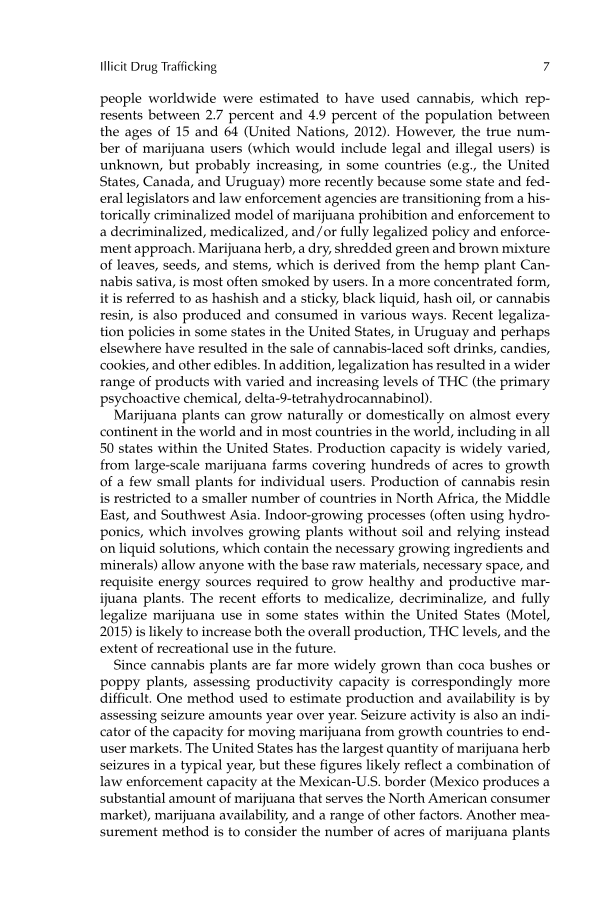Illicit Drug Trafficking 7
people worldwide were estimated to have used cannabis, which rep-
resents between 2.7 percent and 4.9 percent of the population between
the ages of 15 and 64 (United Nations, 2012). However, the true num-
ber of marijuana users (which would include legal and illegal users) is
unknown, but probably increasing, in some countries (e.g., the United
States, Canada, and Uruguay) more recently because some state and fed-
eral legislators and law enforcement agencies are transitioning from a his-
torically criminalized model of marijuana prohibition and enforcement to
a decriminalized, medicalized, and/or fully legalized policy and enforce-
ment approach. Marijuana herb, a dry, shredded green and brown mixture
of leaves, seeds, and stems, which is derived from the hemp plant Can-
nabis sativa, is most often smoked by users. In a more concentrated form,
it is referred to as hashish and a sticky, black liquid, hash oil, or cannabis
resin, is also produced and consumed in various ways. Recent legaliza-
tion policies in some states in the United States, in Uruguay and perhaps
elsewhere have resulted in the sale of cannabis-laced soft drinks, candies,
cookies, and other edibles. In addition, legalization has resulted in a wider
range of products with varied and increasing levels of THC (the primary
psychoactive chemical, delta-9-tetrahydrocannabinol).
Marijuana plants can grow naturally or domestically on almost every
continent in the world and in most countries in the world, including in all
50 states within the United States. Production capacity is widely varied,
from large-scale marijuana farms covering hundreds of acres to growth
of a few small plants for individual users. Production of cannabis resin
is restricted to a smaller number of countries in North Africa, the Middle
East, and Southwest Asia. Indoor-growing processes (often using hydro-
ponics, which involves growing plants without soil and relying instead
on liquid solutions, which contain the necessary growing ingredients and
minerals) allow anyone with the base raw materials, necessary space, and
requisite energy sources required to grow healthy and productive mar-
ijuana plants. The recent efforts to medicalize, decriminalize, and fully
legalize marijuana use in some states within the United States (Motel,
2015) is likely to increase both the overall production, THC levels, and the
extent of recreational use in the future.
Since cannabis plants are far more widely grown than coca bushes or
poppy plants, assessing productivity capacity is correspondingly more
difficult. One method used to estimate production and availability is by
assessing seizure amounts year over year. Seizure activity is also an indi-
cator of the capacity for moving marijuana from growth countries to end-
user markets. The United States has the largest quantity of marijuana herb
seizures in a typical year, but these figures likely reflect a combination of
law enforcement capacity at the Mexican-U.S. border (Mexico produces a
substantial amount of marijuana that serves the North American consumer
market), marijuana availability, and a range of other factors. Another mea-
surement method is to consider the number of acres of marijuana plants


























































































































































































































































































































































































































































































































































































































































































































































